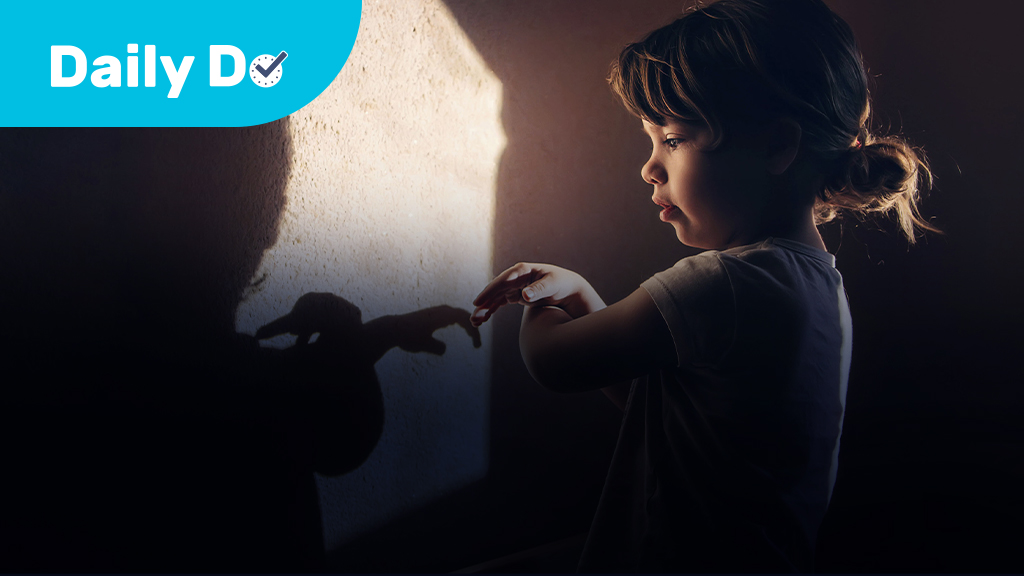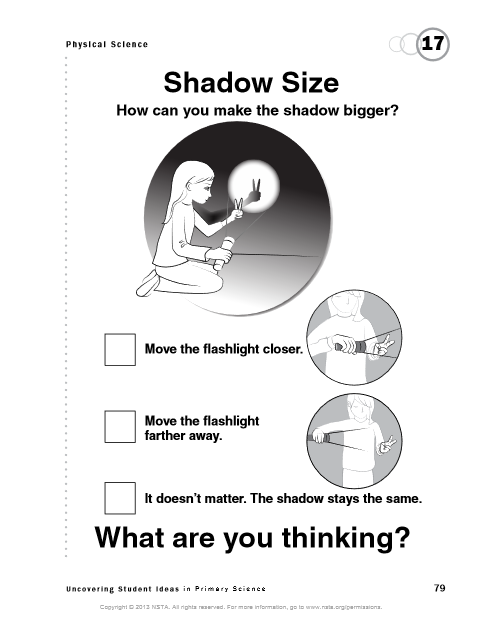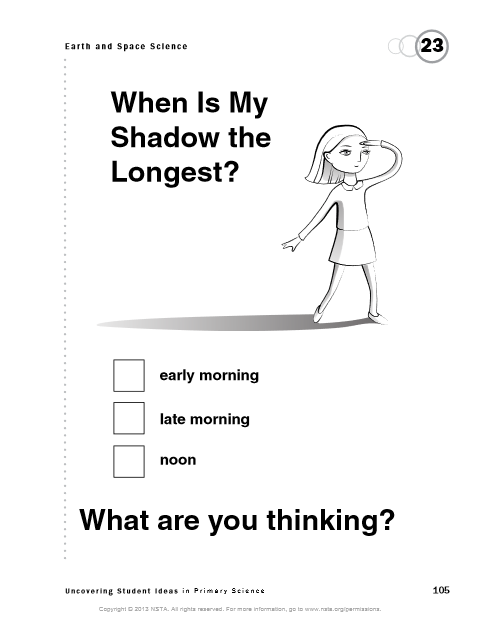Elementary | Daily Do
Why Is My Shadow Always Changing?

Crosscutting Concepts Disciplinary Core Ideas Earth & Space Science Is Lesson Plan NGSS Science and Engineering Practices Three-Dimensional Learning Elementary Grade 1 Grade 5
Welcome to NSTA's Daily Do
Teachers and families across the country are facing a new reality of providing opportunities for students to do science through distance and home learning. The Daily Do is one of the ways NSTA is supporting teachers and families with this endeavor. Each weekday, NSTA will share a sensemaking task teachers and families can use to engage their students in authentic, relevant science learning. We encourage families to make time for family science learning (science is a social process!) and are dedicated to helping students and their families find balance between learning science and the day-to-day responsibilities they have to stay healthy and safe.
Interested in learning about other ways NSTA is supporting teachers and families? Visit the NSTA homepage.
What Is Sensemaking?
Sensemaking is actively trying to figure out how the world works (science) or how to design solutions to problems (engineering). Students do science and engineering through the science and engineering practices. Engaging in these practices necessitates that students be part of a learning community to be able to share ideas, evaluate competing ideas, give and receive critique, and reach consensus. Whether this community of learners is made up of classmates or family members, students and adults build and refine science and engineering knowledge together.
Introduction
Shadows are very popular in children's literature. Characters try to reconnect with a shadow as in Peter Pan, or the Boy Who Wouldn't Grow Up; try to lose a shadow, which is difficult when Nothing Sticks Like a Shadow; and watch Shadows that break loose, unwind, stretch, stir, and branch out upon waking. Young people—and likely many adults—are intrigued by shadows.
In this task, Why is my shadow always changing?, NSTA Press author Page Keeley shares strategies for using formative assessment probes to engage students in productive talk and science and engineering practices to figure out why shadows change size. These strategies can be used in the classroom and at home to make students' thinking visible, which both drives students to investigate their own ideas and question and guides educators in planning instruction.
Today's Daily Do is also featured on the NSTA Blog.
On the Having of Wonderful Ideas About Science
Science is about making sense of our natural world, and this is something that children naturally do long before they begin school. Children acquire information from many sources: interacting with their environment, conversing with their families and friends, and picking up ideas in books and from the media. Children are constantly taking in new information and trying to make sense of it. For elementary-age children, parents and teachers can be guides and facilitators in supporting children in their wonderings and in helping them develop their ideas about science.
The video below is an introduction to tools we have developed in the Uncovering Student Ideas in Science series that you can use at home or through online learning to help students formulate their ideas and share them as they explore phenomena and science concepts.
Learning About Light and Shadows
So let’s explore shadows with two probes called Shadow Size and When Is My Shadow the Longest? The first probe, Shadow Size, helps children develop ideas about how light interacts with objects and forms shadows. The second probe helps children recognize how shadows change throughout the day based on the Sun's location in the sky. These probes are from Uncovering Student Ideas in Primary Science, Volume 1. Use these downloadable sheets or view them on a computer/tablet to start a conversation with the children. How would you make the shadow larger if you were the child in the illustration? When do you think your shadow outside will be the longest—early morning, late morning, or noon?
| Table 1 | ||
|---|---|---|
|
Tips for Talking With Children About the Probes
The activities I discuss below illustrate how probes are used in three steps:
- Activate children's preconceptions.
- Engage them in experiences during which they acquire evidence and new information.
- Have them use what they discovered to revisit and revise initial thinking.
Throughout this process, it’s important that parents and teachers focus on letting children express their ideas. Try not to comment on whether an idea is accurate or “good.” Don’t correct children when they share a misconception. Instead, make comments like “tell me more about that” or “what else do you think about ___?” These open-ended prompts can invite more detailed discussion.
Explore Shadow Size
Let's begin our investigation of shadows. You will need paper, scissors, tape, a pencil or craft stick, and a flashlight.
- Ask your students to draw a simple shape (circle, triangle, etc.), then cut it out. The shape should be about the size of a sticky note (it can be a little bigger or a little smaller).
- Place the shape near the top of a pencil, then attach it with tape.
- Ask students to shine the flashlight on their paper shape. Ask, "Do you see your shape's shadow?" Make sure they can point out the shadow before asking them to turn their flashlight off.
- Ask, "How do you think you could make the shadow bigger? Share the Shadow Size probe with your students. Give students time to think about their experiences with shadows. Ask students to choose the response they agree with and share their thinking. (You may ask students to write what they are thinking before sharing.)
- Make the room as dark as you can (don't worry if you can't block out all the light). Let students explore how to make the shadow larger or smaller. Ask, "Do your observations match your predictions?"
- Guide students to look for cause-and-effect relationships (use cause and effect as a tool for thinking). For example, ask students to complete these sentences: “When I move the flashlight closer to my paper shape, the shadow _____. When I move the flashlight farther away from my paper shape, the shadow ____.”
- Challenge students to make the largest shadow they can with their paper shape, and then make the smallest shadow.
- Revisit the Shadow Size probe. Give students time to think about their new experiences with shadows and choose a response. Ask students, "Why did you choose this response? What did you notice in the investigation that makes you agree with this response?"
These questions get students to support their claim (the response they chose) with evidence (what they noticed in the investigation).
Background for the Parent and Teacher
The Shadow Size probe for teachers and parents provides background information and context on the purpose of the probe and the research summaries of the commonly held ideas in this area of science. The probe is designed to elicit young children’s ideas about how light interacts with an object to form a shadow. It helps reveal children’s ideas about the size of a shadow in relation to its distance from the light source. However, sometimes children’s preconceptions can affect how they think about a phenomenon. For example, one study found that some children think the size of a shadow depends solely on the size of the object, failing to recognize the role of light.
The When Is My Shadow the Longest? probe for teachers and parents is designed to reveal children’s ideas about shadows and how they think shadows change from sunrise to noon. Research has found that some children think their shadow stays the same shape and size throughout the day. The background information also provides suggestions for further instruction. For example, you can extend the probe by having children make measurements throughout the day.
As the renowned educator and scholar Eleanor Duckworth said in her classic book, The Having of Wonderful Ideas (Teachers College Press 2006), “The more we help children to have their wonderful ideas and to feel good about themselves for having them, the more likely it is that they will someday happen upon wonderful ideas that no one else has happened upon before.” These probes provide an opportunity for children to share their wonderful ideas in a nonjudgmental way and to discover for themselves when to modify their thinking.
NSTA Collection of Resources for Today's Daily Do
NSTA has created a Why is my shadow always changing? collection of resources to support teachers and families using this task. If you're an NSTA member, you can add this collection to your library by clicking ADD TO MY LIBRARY, located near the top of the page (at right in the blue box).
Check Out Previous Daily Dos From NSTA
The NSTA Daily Do is an open educational resource (OER) and can be used by educators and families providing students distance and home science learning. Access the entire collection of NSTA Daily Dos.




